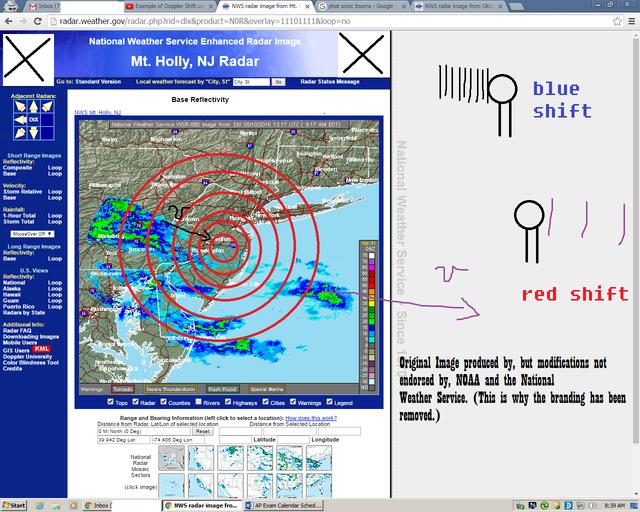MAKE A MEME
View Large Image

| View Original: | Doppler_Effect_(3_3).png (1280x1024) | |||
| Download: | Original | Medium | Small | Thumb |
| Courtesy of: | www.flickr.com | More Like This | ||
| Keywords: The Doppler effect is most useful to us when it is used with light waves instead of sound waves. You learned in the electricity/magnetism unit that in the visible spectrum, light waves with the lowest frequencies are perceived as red colored, and visible light waves with the highest frequencies are perceived as blue/violet. Doppler radar works by emitting light waves at microwave frequencies and looking for changes in the apparent frequency of light of the waves as they bounce off the weather phenomenon and come back. If there's a blue shift (in other words, an apparent higher frequency coming back) then the storm is approaching the radar, and if there's a red shift (a lower frequency than what was sent out,) the storm is moving away. Weather radar design is really complicated, and the above is an over simplification- see here for more details. en.wikipedia.org/wiki/Weather_radar The National Weather Service maintains a nationwide network of weather radars, which has saved many lives over the years. Here are some radars that are of relevance for my students: TLX Radar, located in Central Oklahoma between Draper Lake and Lake Thunderbird (TLX stands for Twin Lakes) radar.weather.gov/radar.php?rid=TLX OKX Radar, located at Brookhaven National Labs on Long Island, is the NWS radar for Connecticut radar.weather.gov/radar.php?rid=OKX The Doppler effect is also essential to understanding how modern astronomy works. By looking at the spectra from distant stars, we can tell what element they're made of (we'll discuss this in the light unit.) But sometimes, the fingerprint of a certain element appears to have shifted to higher than expected frequencies (blue shift) or lower than expected frequencies (red shift.) This tells us whether that star or galaxy is moving towards us or away from us, and is what convinced us that the universe is expanding. The Doppler effect is most useful to us when it is used with light waves instead of sound waves. You learned in the electricity/magnetism unit that in the visible spectrum, light waves with the lowest frequencies are perceived as red colored, and visible light waves with the highest frequencies are perceived as blue/violet. Doppler radar works by emitting light waves at microwave frequencies and looking for changes in the apparent frequency of light of the waves as they bounce off the weather phenomenon and come back. If there's a blue shift (in other words, an apparent higher frequency coming back) then the storm is approaching the radar, and if there's a red shift (a lower frequency than what was sent out,) the storm is moving away. Weather radar design is really complicated, and the above is an over simplification- see here for more details. en.wikipedia.org/wiki/Weather_radar The National Weather Service maintains a nationwide network of weather radars, which has saved many lives over the years. Here are some radars that are of relevance for my students: TLX Radar, located in Central Oklahoma between Draper Lake and Lake Thunderbird (TLX stands for Twin Lakes) radar.weather.gov/radar.php?rid=TLX OKX Radar, located at Brookhaven National Labs on Long Island, is the NWS radar for Connecticut radar.weather.gov/radar.php?rid=OKX The Doppler effect is also essential to understanding how modern astronomy works. By looking at the spectra from distant stars, we can tell what element they're made of (we'll discuss this in the light unit.) But sometimes, the fingerprint of a certain element appears to have shifted to higher than expected frequencies (blue shift) or lower than expected frequencies (red shift.) This tells us whether that star or galaxy is moving towards us or away from us, and is what convinced us that the universe is expanding. | ||||